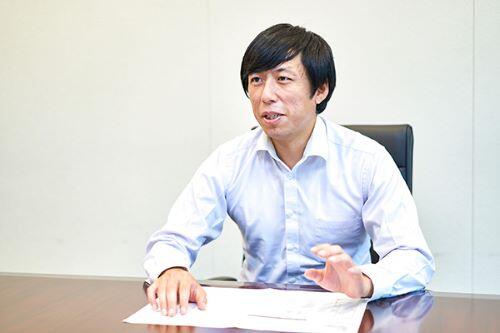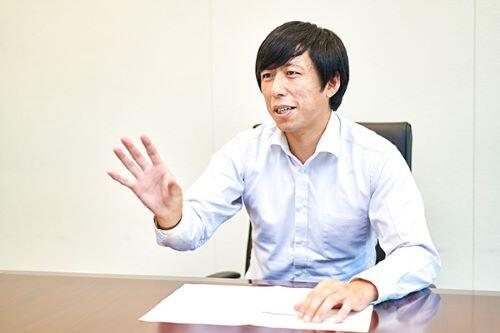Speaker: Business Engineering Corporation
Business Engineering Co., Ltd.
Solution Business Headquarters
SCM Solutions Division 1
Ryosuke Takamatsu

For the manufacturing industry, planning, which is the basis of all business operations, is becoming increasingly difficult as the industry faces sudden changes in demand due to diversifying customer needs, as well as unforeseen circumstances such as infectious disease pandemics.
Ryosuke Takamatsu of the Solutions Business Headquarters, SCM Solutions Division 1, deeply understands the background of business operations through close communication with clients and determines the direction for resolving issues through overall optimization, thereby creating the ideal planning system together with the client.
The market demands "resilient planning systems"
For the manufacturing industry, planning is the basis of all production activities. By linking the information generated by the SCM planning system, which is composed of PSI, production planning, MRP, etc. based on supply and demand planning, to MES and scheduling, it is possible to take appropriate action.
However, in recent years, this plan has become more difficult. Ryosuke Takamatsu, Senior Consultant, SCM Solutions Division 1, Solutions Business Headquarters, explains:
"In the days when products could be sold as long as they were made, it was enough to make daily production plans, but now that customer needs are diversifying, demand is changing rapidly. Furthermore, unpredictable situations can occur, such as problems with manufacturing equipment or, as in the current COVID-19 pandemic, when the supply of raw materials from suppliers or the global logistics network is halted. In such emergencies, plans need to be reworked quickly, but with a tight lead time, it is difficult to respond in time, and in the worst case scenario, orders may be canceled."
Up until now, planning could be done by simply inputting data into Excel and tabulating it, but now that high-mix, small-lot production and mass-customized production are the norm, the number of parts handled has exploded and production conditions have become more complex. It is necessary to recognize that manual response has reached its limit, and Takamatsu emphasizes that "there is a demand for planning systems that support resilient production activities that can flexibly respond to sudden changes in the market and unforeseen circumstances."
Take immediate action to address the issue
Let's take a look at some actual cases in which Takamatsu has worked to solve problems with planning systems in a variety of manufacturing industries.
A health food (supplement) manufacturer had a fabless system in which all manufacturing was outsourced, and they procured and managed supplies for their partner factories based on a drafted outsourcing plan. However, this health food manufacturer was troubled by frequent delays in delivery from their subcontractors.
"What this client lacked was a plan that more accurately assessed the manufacturing capabilities of their subcontractors. In addition, the client's business itself was growing steadily, so they urgently needed to introduce a system that would enable them to make rapid changes to their plans in order to support a product supply system that could keep up with the sudden increase in demand and the launch of new products." (Takamatsu)
Therefore, the first thing they did was to introduce a scheduler (load adjustment, sequence planning). Using this as a base, they systemized a series of operations, from production planning to PSI management, and procurement and management of supplies, and created an environment in which they could concentrate on planning work by streamlining information gathering.
As a next step, we proposed introducing the same scheduler to the main partner factory, creating a system where information could be shared between the client and the supplier and production could proceed according to plan.
"As a result, when a delay occurs in the manufacturing process, we can detect it more quickly, identify the extent of the impact, and take swift action to deal with it," says Takamatsu.
From fit and gap analysis of the new system to the to-be image of the plan
Formulated

The second case we will look at is a replacement project for a planning system at a semiconductor manufacturer. This semiconductor manufacturer had originally introduced a highly functional supply and demand planning management system, but the support period for this system had already expired and the system was still in operation without adequate maintenance. In addition, the people in charge at the time of the introduction were being transferred or retiring one after another, and there was a risk that the system would become a black box if things continued as they were. This is why the manufacturer decided to replace it.
"Upgrading the current system to the latest version was an option, but supporting advanced planning meant high license fees, and the client wanted to reduce operational costs by switching to a cheaper system," says Takamatsu.
However, this causes a problem as it reduces the functionality of the planning system, which inevitably creates a gap between the system and current operations.
"So we carefully reexamined the specifications of the current system and held repeated discussions to analyze the fit and gaps of the new system, and then we formulated the to-be vision of the plan," said Takamatsu.
It is not necessarily the case that the more advanced a planning system is, the better. It is important that all parties involved understand the business background, share an image of what the plan should look like, and find a direction for overall optimization that does not fall into the trap of individual optimization based on functionality.
Discrete systems also have the same concept of planning and management as process systems.
In reference

Another example I would like to mention is a project to revamp a planning system at a machinery manufacturer.
After creating budgets and annual and monthly production plans, this machinery manufacturer creates weekly plans for so-called "one-piece flow production," which determines the order in which each product is manufactured, on the ERP system. This process is handled by a large number of add-ons that have been added over the years.
Of course, this was not a problem until now, but now that the end of support for this ERP is approaching and upgrading to the latest product is urgent, the issue of these add-ons has come to the forefront again, because migrating and rebuilding the add-ons to a new ERP platform will require a huge amount of man-hours and costs.
The machinery manufacturer therefore decided to take this opportunity to revise its planning system to a simpler platform.
"The customer's decision to look ahead to future operations is correct, and from B-EN-G's experience, the most important prerequisite for a planning system is that it is simple and flexible. For the manufacturing industry, it is important to be able to flexibly review plans while looking at data at the time, but in order to respond to the sudden changes in the market and unforeseen circumstances mentioned above, the planning system itself must be able to flexibly change its structure, such as by quickly introducing new ideas," says Takamatsu.
The proposal was based on a scheduler that B-EN-G has implemented at a steel manufacturer. It may seem surprising to apply a scheduler for a process system in a completely different industry, but this is exactly the kind of change in thinking that is required.
"Even if the steel products have the same part number, it is essential to plan and manage the post-processing, which processes materials with complex input order constraints according to the production conditions at the time, as well as the pre-processing, which prepares each input material in a different state. This approach is exactly the same as our customers' single-piece flow production. Even in discrete system planning, as we move from mass production to high-mix, small-lot production and mass customization, the approach to planning and management in process systems is very useful." (Takamatsu)
To reiterate, the most important thing for a manufacturing planning system is to realize a mechanism that can detect various problems occurring in the manufacturing process at an early stage, identify the scope of their impact, and encourage rapid action.
"Even when a project is in progress, we always make sure to build relationships where the client can feel free to talk to us when they come up with a new requirement," says Takamatsu, adding that they will continue to work together with clients to create "the ideal planning system" that can flexibly respond to sudden changes in the environment and unforeseen circumstances, based on close communication.







